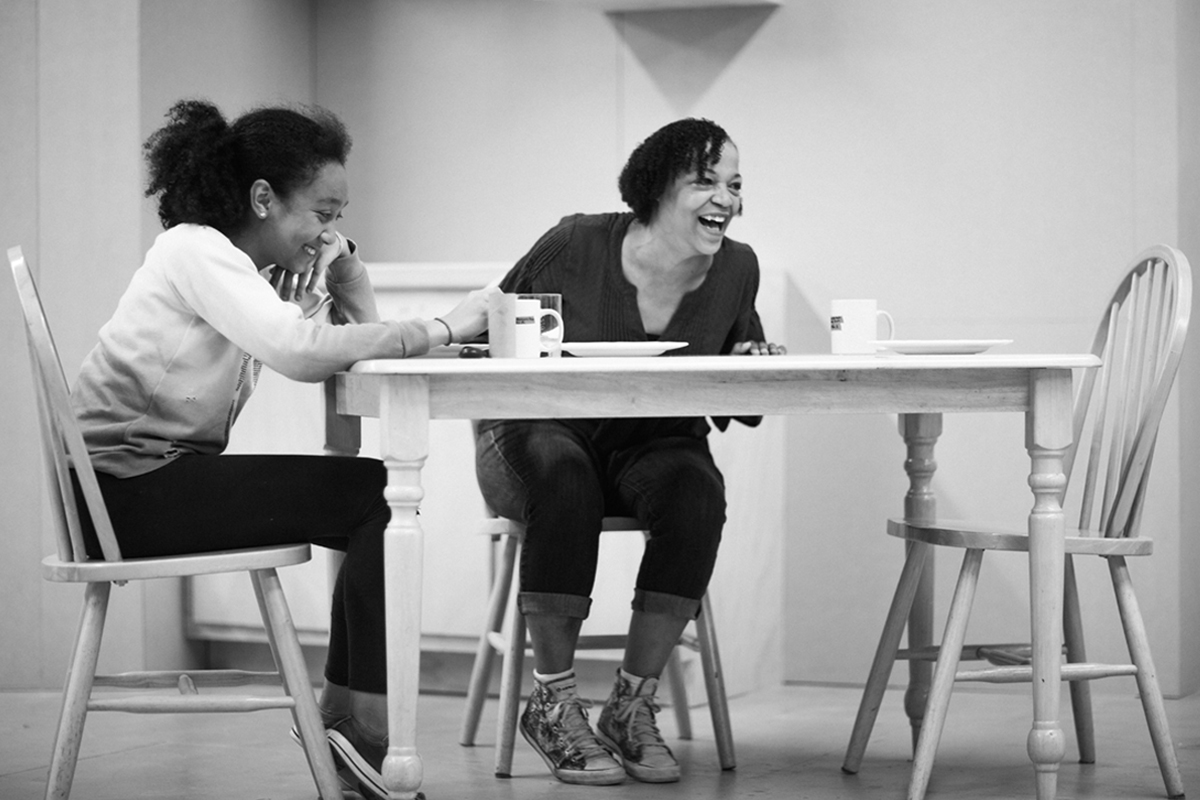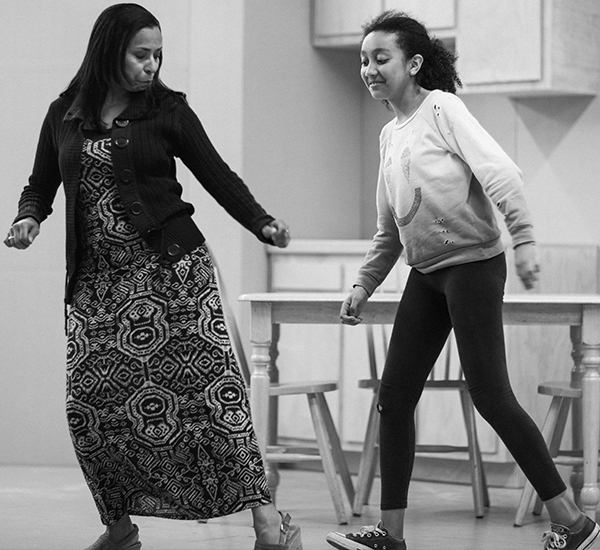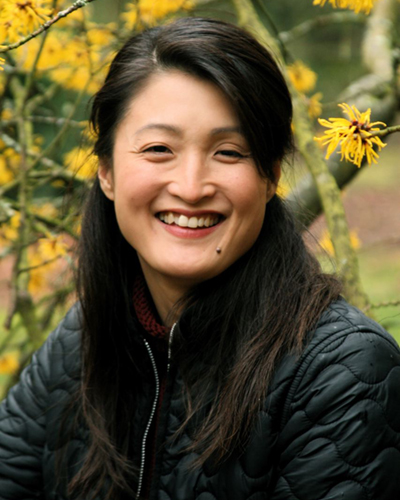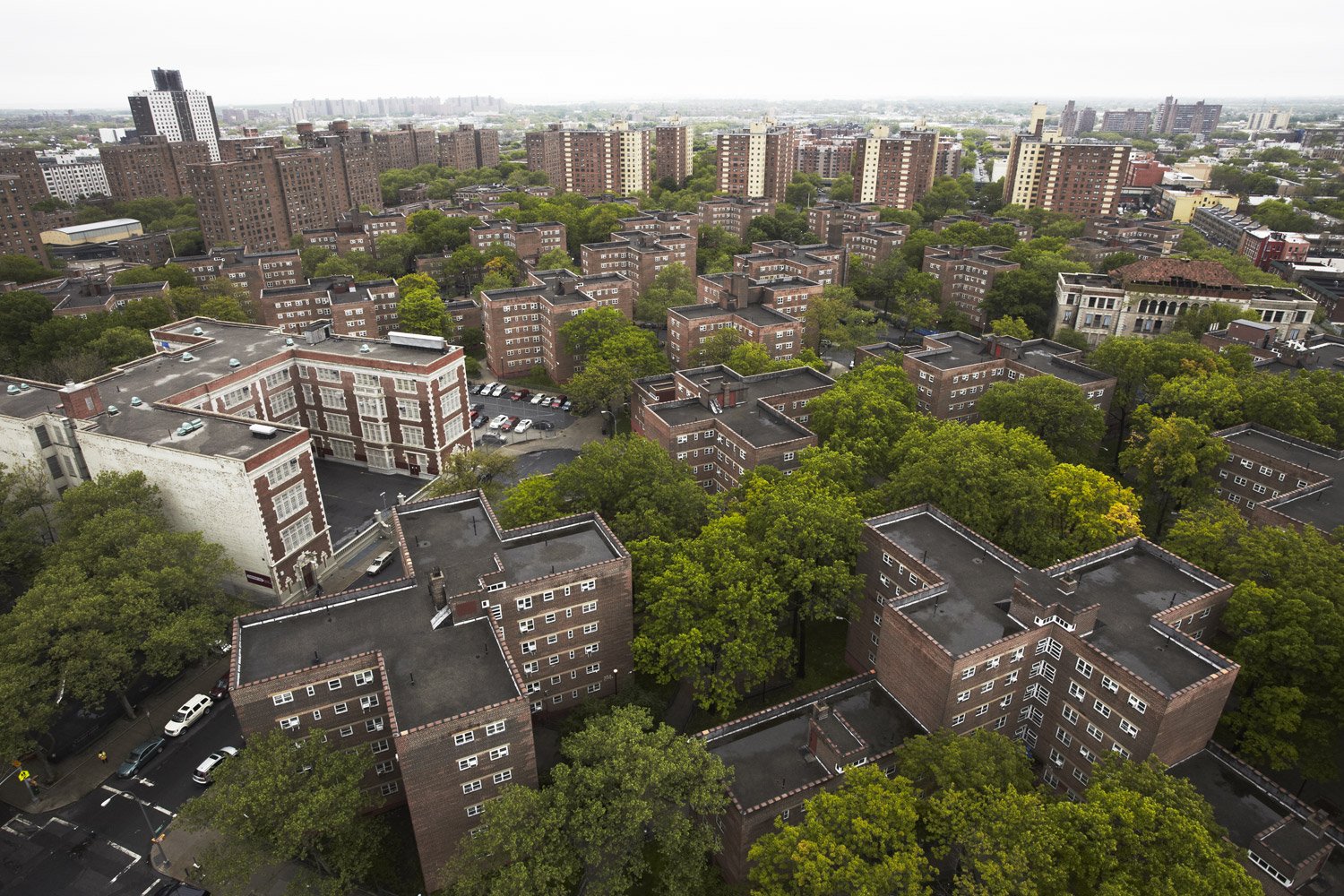The Story

Mimia Ousilas as Devine and Cathleen Riddley as Lena in rehearsal. Photo by Jessica Palopoli.
Moving fluidly between past and present, brownsville song is a story about loss and renewal, grief and healing. When tragedy strikes, how do we come together? brownsville is a raw, visceral tale of the ties that bind. Every record has a b-side, and so do the stories of our lives. While not every person is a hit single, every life is a rich, beautiful song that deserves to be heard.
Dramaturg Amy Mueller (artistic director of the Bay Area Playwright’s Foundation), has a long rich history with the play. brownsville song (b-side for tray) received its early development at the Bay Area Playwrights’ Festival in 2013. She’s drawn to the script as a vehicle for understanding how a community can heal. She says: “this play speaks so beautifully, and with poetic eloquence, about the pain mothers, daughters, sons, and lovers feel in the absence of their men, who have been taken from their communities by violence. What speaks to me most in this piece are the joyful moments of remembered connection, and the slow reconciliation of broken family bonds.”
From the Director

Director Margo Hall and Mimia Ousilas as Devine, in rehearsal. Photo by Jessica Palopoli.
Shotgun Players is honored to have Margo Hall as the director for brownsville song. Margo is a founding member of Campo Santo Theatre, and has worked as an actor, director, and playwright throughout the Bay Area and beyond. With Shotgun Players, she co-directed Bulrusher with Ellen Sebastian Chang in 2007 and in 2009 she played the lead in Marcus Gardley’s This World In a Woman’s Hands. Regarding brownsville song she writes:
“I heard a reading of brownsville song (b-side for tray) in the 2013 Bay Area Playwrights Festival and fell in love with the play. The joy and pain expressed in the 90 minute run time was a roller coaster ride that somehow left me hopeful. Hopeful that the audience that witnessed this story with me was reminded that the death of someone from gun violence affects everyone and everything around them. And hopeful that after seeing this play, the people of these audiences will be motivated to do something to eliminate gun violence in their respective communities. Each individual who falls victim to gun violence had a name, a family, and a community. Kimber Lee gives us an opportunity to pay homage to all those families and communities who have been victims of gun violence. Lee reminds us that we are all part of these concentric circles of death and love.”
Youth Spirit Artworks
Actress Ryan Nicole Austin is working both as the assistant director and community outreach coordinator for brownsville song (b-side for tray). Ms. Austin will be working with Youth Spirit Artworks “to create an artistic space that serves as a community memorial for lives lost to gun violence. This artistic space is purposed to blur the lines between the world of the play and the respective worlds we all live in, to encourage and inspire agency in the play's attendees. The memorial will extend from the walls of the set flanking the theater seats and continue outdoors to the front of the Ashby Stage. We want all members of community and the audiences that attend brownsville to participate in the memorial by leaving a flower, candle or trinket outside and by placing names of people lost to gun violence.” Youth Spirit Artworks provides job training for low income and at-risk youth in the Bay Area, using art as the vocational medium. Check out their work here!
Playwright Kimber Lee

In an interview with Seattle Repertory Theatre, playwright Kimber Lee discussed her inspiration for brownsville song (b-side for tray):
“In 2012, I read a very simply-written story on a blog about the loss of a young man in Brownsville. The brief post only contained a few facts about the young man who had died. But it lodged in my gut and wouldn’t let go. I kept thinking about this boy’s family and loved ones. I kept thinking about the tremendous loss of life in some of our communities, and how easy it is in this soundbite world for these losses to disappear from our consciousness, and how that is especially true for a neighborhood like Brownsville, which only makes the news when something bad happens. Then everyone forgets about it until the next incident, and nobody bothers to look more deeply into the fact that Brownsville has been an under-served, ignored section of New York City since its inception. Often there can be this sort of head-shaking resignation–“Oh well, that’s just what happens there”–or an assumption that if you look a certain way and live in a certain zip code, your life is worth less, you matter less, and this sort of wall silence descends around the loss.
“And all of this was going around in a circle in my head. I didn’t know what I could do about it, what I could offer–how to bear witness in meaningful way. And I was trying to work on another project, but Lena’s voice came blazing from me, this push against that silence and forgetting.
“And to be clear, this play is not about the young man from the blog post, whose name was Tray Franklin–I included several facts from that case, but the characters and relationships are completely fictional, although there are unfortunately many stories of similar incidents our country.”
In response to a question about setting her play in the Brownsville neighborhood of New York City, Kimber Lee says:
“The short answer is that Brownsville is where the young man I read about was killed. The deeper truth is that I believe we all bear responsibility for the systemic neglect which creates and perpetuates conditions that lead to the kind of challenges faced by a community like Brownsville. And then, those of us who can, avoid those neighborhoods because they are so ‘dangerous’ – there is a great feeling of separateness, and though most of these places are a short train ride away, they can sometimes feel like they are on another planet. Why do we allow this to continue?
“What is our collective responsibility here? What policies create and perpetuate these troubles? What are the forces that combine to make good options for a future for some of our young people seem impossibly out of reach? What is the untruth of the seductive “one who made it out of the hood” story-line, and how does it obscure our broader societal responsibility for the conditions in these neighborhoods? All of these questions swirl around for me, but the deepest truth about the writing of the play is that I simply wanted to bring that family’s pain and loss into close, personal contact with audiences who may never even have heard of Brownsville. I believe so strongly that we are all connected on a deep level, our humanity and our survival are so inextricably linked to our mutual well being, whether we live on Queen Anne or in Brownsville. And with every loss, our humanity is diminished.”
The Title
In an interview with the Lincoln Center in New York City, Kimber Lee responded to a question regarding the title of the play: “I wanted a title that could encompass the feeling of a lament, of mourning, but that would also contain hope and sense of celebrating a life. And the ‘b-side’ - for those of you who don't remember record singles (45rpm) - the hit single would always have a not as popular, or unknown song on the other side. I wanted Tray's song to show us a side of a familiar story that we may not have considered before.”
Who Defines Your Community?

Dramaturg Amy Mueller provided detailed background information for the cast about the Brownsville neighborhood in New York. Located in the eastern part of Brooklyn, it is an isolated neighborhood, enclosed by tall, imposing, brown brick public housing units, inhabited by thousands of families within a small radius, putting everyone living there in very close proximity, in an area with a reputation for violence. That is one side of the story. Back in 1916, Margaret Sanger opened the first birth control clinic in the Brownsville neighborhood. Today, it is a area that, as playwright Kimber Lee describes, “only makes the news when something bad happens.” People often relate similarly to areas in our own Bay Area neighborhoods/cities, as if the perspective of the dominant culture is what define us. But looking at our own area, it’s easy to see how the rich cultural strengths of family and community can provide a different picture. Tray is, in his own words, ‘more than meets the eye.’ The playwright, who is a boxer herself, centered his identity around the boxing studio, where he discovers that he can overcome injury with stamina - which becomes a metaphor for his life. But what happens when one becomes a statistic? Who defines your community, your fallen? Below are just two of the contracting articles that dramaturg Amy Mueller shared with the cast:
No ‘Inner City’ in Brownsville, Brooklyn, Just Overlooked Strengths
—Ginia Bellefante, New York Times
“If kids have access and exposure they can change a trajectory,” she said, “but you can’t know what to ask for until you know what there is to want.”
Brownsville: Inside One of Brooklyn's Most Dangerous Neighborhoods
—Feifei Sun, Time
“Brownsville, located in east Brooklyn, has long been one of New York City’s most dangerous neighborhoods."
Ultimately, we can take inspiration from the character of Tray who shares with us:
No matter what anyone else says to you
or thinks about you
or does to you
You define your life
By living it
Day by day
Every moment is a chance to rise
To fulfill the gifts of your life
To write hope into your story





